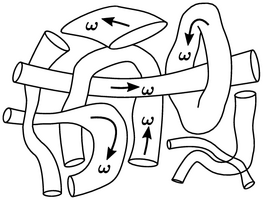6.2 A picture of turbulence
In turbulent flow, the fluid follows irregular curved paths, known as eddies. Eddies are generally illustrated by curved arrows, which does little to reveal the true nature of turbulence.
Instead, we can build a picture of turbulence from: photographs and videos from experiments, examples from engineering and everyday experiences; and, from images and animations from detailed computer simulations.

Generally, we see a mass of intertwined, flow structures of many different sizes. The structures move and rotate continuously. Through interactions with one another and the main flow field, they change shape and size rapidly.
The structures indicate regions of vorticity  in the fluid, as defined
in Sec. 2.11
. It is vorticity, not
velocity, which is often used to describe turbulence. For example,
Davidson2
describes turbulence as “a
spatially complex distribution of vorticity which advects itself in
a chaotic manner”, and a turbulent
eddy as “a blob, tube or sheet of vorticity and the
associated flow.”
in the fluid, as defined
in Sec. 2.11
. It is vorticity, not
velocity, which is often used to describe turbulence. For example,
Davidson2
describes turbulence as “a
spatially complex distribution of vorticity which advects itself in
a chaotic manner”, and a turbulent
eddy as “a blob, tube or sheet of vorticity and the
associated flow.”
Vorticity generation
Vorticity is primarily generated at solid boundaries and can be categorised as “fast” or “slow”.3 Fast generation is localised to regions of relative acceleration between the solid and fluid, e.g. at the leading edge in flow over a semi-infinite flat plate or at the lip at the exhaust of the air cannon in Sec. 2.11 .
Slow generation occurs over longer sections of boundary surface, e.g. the wall of a pipe with internal fluid flow. It is caused by the tangential pressure gradient at the surface.

Since vorticity is mostly generated at solid boundaries, we can try to imagine the how vortex structures might evolve. Consider a layer of a viscoelastic fluid on a flat surface — something like a sticky adhesive or putty. When shear is applied, the material tends to rotate rather than slide horizonatally.
Sections of material can break off and form tubes which roll across the surface. They tend to extend along their length and bend under uneven shear.
When we apply shear by hand, we can feel that the
rotation is initiated within the uneven points, e.g. around the finger joints. In a
similar way, the onset of turbulence is sensitive to surface
roughness with the transition from laminar to turbulent flow
occurring at higher  for smoother surfaces.
for smoother surfaces.

